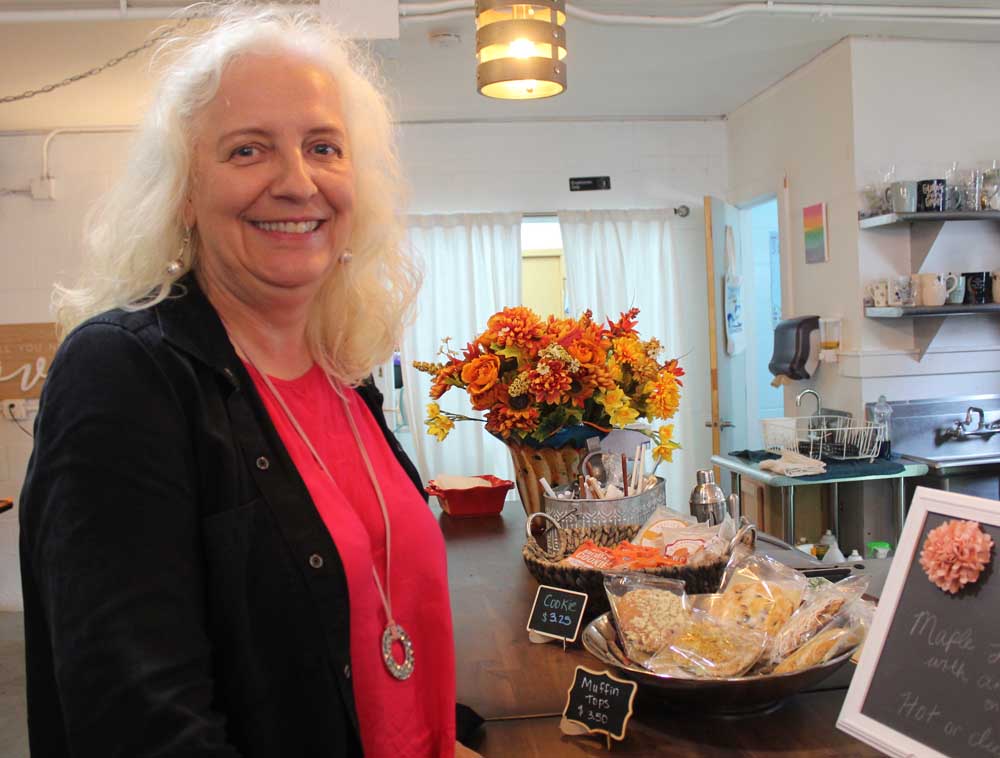An unfinished Finnish mystery
Published 8:29 am Friday, December 1, 2023

- Maarit Tastula, a journalist visiting from Finland, waits for her order at the Ebb Tide Cafe in Ilwaco a couple of days before returning home after a three-week vacation and research visit seeking details of ancestors who emigrated to the United States then moved to Russia during the Soviet era. To add to the authenticity of her trip, she stayed some nights in Astoria’s Uniontown opposite the old Suomi Hall building.
Maarit Tastula left the Lower Columbia region to return to Finland with a smile.
She may not have fully accomplished her historical research mission. But she was delighted with the help she received.
Tastula, a prominent journalist in Tampere, Finland’s second-largest city, traveled to meet with historians and descendants of Finns in Naselle, Ilwaco and Astoria.
Maarit Tastula continued to seek help about this period of Finnish history. Her email address is maarit.tastula@yle.fi.
She urges people to save letters and other documents to preserve history and present them to museums.
She is researching information about Finns who first emigrated to the United States in the early years of the 20th Century then were lured back to Europe when the Great Depression struck.
Specifically, she was trying to trace evidence from the lives of Finns who ended up in the Karelia region across the Russian border from their homeland. Soviet dictator Joseph Stalin had thousands executed in 1937 and 1938.
‘A curious person’
Tastula, 61, works for YLE, the Finnish National Broadcasting Company. She has hosted interview shows and produced films. “I am a little bit too passionate about this,” she smiled. “It started during covid: I had to find something to study! There’s little time left. I have to do what you want to do in life.”
Later, when the war in Ukraine closed access to Russian archives, she decided to retrace family footsteps around the Columbia River estuary. “It’s a funny way to have a holiday!” she said. “I was so curious about those people who went abroad and started a new life.
“I have become such a curious person,” she added, teasing. “I want to ‘detect’ the crimes.”
On her visit to the Long Beach Peninsula and Astoria, she collected information for a possible book.
“I want to understand the circumstances that they have lived,” she explained, “and you really get hooked. The Finnish immigrants to the United States, most worked the roughest jobs, loggers, fishermen and many were miners.
“The world was a little bit different from now. They didn’t have human rights. They had to have trade unions to fight against the owners of the companies. If you are alone, you cannot fight. But if you are together, you can do better.”
Karelia fever
Tastula said that when the Great Depression impoverished the United States, many Finns caught “Karelia fever” — hearing of lucrative and permanent job prospects in the Soviet region adjoining their homeland.
Finnish language newspapers published in the United States quoted charismatic leaders in the Socialist movement.
“They said in Russia there would be work for everybody, and fair treatment,” she said, “and every person would have the same human value, human rights. Perhaps it was like that at the beginning, but the situation changed.”
“Everybody thought, ‘We are going there to make money and become rich,’ and many thought they would work for a couple of years and go back to Finland. It was not so easy.”
Instead, when they arrived their passports were confiscated and working conditions were unsafe. “At midnight, the cars came to bring the people to the jails,” Tastula said. “I tried to think of relatives of mine and whether they thought they had made the craziest mistake of their lives.”
She was especially interested in the fates of three brothers who were her grandmother’s cousins:
• Oiva Kangas and his wife Rauha (neé Saari), who had a son, Maurice Robert, born in the United States;
• Kristian and Signe, who stayed in the U.S. for 20 years;
• William, who was single.
Oiva and Kristian were among immigrants who worked in fish cooperatives in the Astoria-Ilwaco area then returned to Europe in 1932-33; she has a record showing William lost his American citizenship.
A letter from Signe lamented that she “‘Would like to take away the last 15 years of her life and start again.’ They must have experienced terrible things there,” Tastula said.
‘It was fabulous’
On the North Coast, she received help from Anita Raistakka at the Appelo Archives in Naselle, Donella Lucero at the Columbia Pacific Heritage Museum in Ilwaco and Liisa Penner at the Clatsop County Historical Society in Astoria. Tastula was effusive in praising all three, and others who added assistance. “I want to thank all these lovely people who have helped me in the archives,” she said.
Lucero’s maps helped illuminate the geography for her, but the help went both ways. Tastula viewed Ilwaco’s archives featuring Merle Reinikka, an Appelo founder and national FinnFest stalwart, to learn of early Finns in Ilwaco. “Maarit was also able to assist us by translating several documents written in both Finnish and Swedish,” Lucero’s said. “With her assistance, we now know what the documents are about.”
In Naselle, Raistakka, one of the founding board members of the archives, is the library manager. Two connections in the “small world” department delighted Raistakka, who hosted Tastula with Darlene Bjornsgard and Sirkka Wirkkala.
When the visitor mentioned immigrants Leo and Sylvia Nasi Raistakka all three hosts’ faces lit up. Bjornsgard pointed to Raistakka, who was married to their son, Phil, who died in 2012.
‘They must have experienced terrible things there.’
Maarit Tastula, visiting journalist
Another connection was Elisa Warila, Tastula’s best friend in earlier years. Warila, from Kaustinen, home of the largest annual folk festival in the Nordic nations, is Wirkkala’s first cousin.
“It was fabulous,” said Raistakka, who is 78. “She asked about different people’s names. There was still more, but it was at the end of her visit and she wanted to see some of the coastline. I told her she had to stay another month!”
Questions covered unusual areas. “She asked about houses of prostitution and we said, ‘Yes, we had some in Astoria, Raymond and Aberdeen.’” The discussion even involved the prevalence of sexually transmitted diseases. “I have never seen anything written about this,” Raistakka said.
‘Equal op
portunity’?
Theresa Lorenz helped Tastula set up many contacts and shared her own family links. A relative of Tastula had lived with Lorenz’ great great grandmother Anna Happala when she was widowed.
Her great grandparents, Leander (Anna’s son) and Hilma Aho settled in Ilwaco in the early 1900s, and had five children. Leander was a fisherman and a logger; Hilma would mend fishing nets with the other local Finnish women. They purchased the house where Lorenz now lives in 1910. Their oldest girl was Allie Aho, and they raised their daughter Olivia (Bunny) Connelly in the home.
“Leander’s brother, Alexander and sister Seraphina were part of the Finns that left for Russia,” Lorenz noted. “Seraphina and her family returned; Alexander did not.”
Penner, at the Heritage Museum in Astoria, confirmed that the reverse migration was encouraged by Toveri, the Astoria-based radical Finnish press. “The publications were promoting Karelia, the area between Finland and Russia, but under Russian control, as a place American Finns could go to start communal living, a place where there was equal opportunity for all, where there was hard work ahead, but there would be food for everyone and jobs for everyone and no class distinctions,” she said.
History writer Paul George Hummasti’s 1930s’ family experiences in Karelia were reprinted in Cumtux, the Clatsop Historical Society’s summer 2000 publication. “When the Hummasti family got there, they learned it was all a lie,” Penner said. “I have talked to many people whose relatives went to Karelia and never heard from them again.”
‘I love these small towns’
Over cappuccino at the Ebb Tide Cafe in Ilwaco, Tastula repeatedly apologized for her lack of English vocabulary, yet spoke fluently throughout a courteous conversation. She has traveled around the world, including the United States, as part of her journalism work, but never the Northwest.
“American are so kind and helpful,” she said. “I admire them in that way. I love these small towns. I love to swim. I love the beaches and bike everywhere.”
Her joy at the region’s scenic beauty emphasized the puzzle: why in the 1930s did her relatives give up this part of the United States for the Soviet Union?
“It is a marvelous thing — this is a small paradise,” Tastula said. “That is why I cannot understand why they wanted to leave this place.”









